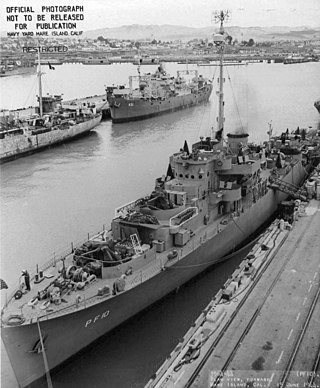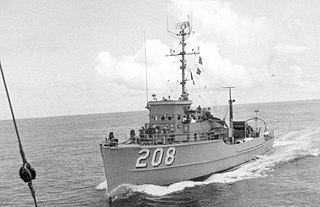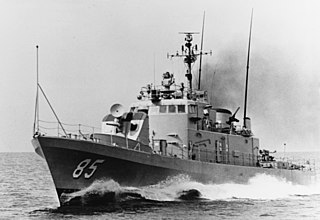
USS Sam Houston (SSBN-609/SSN-609), an Ethan Allen-class submarine, was the second ship of the United States Navy to be named after Sam Houston (1793–1863), president of the Republic of Texas. Sam Houston was the US Navy's seventh ballistic missile submarine.

USS Towers (DD-959/DDG-9) was a Charles F. Adams-class guided missile destroyer of the United States Navy notable for action in the Vietnam War. The ship was named in honor of Admiral John Henry Towers.

USS Paul Revere (APA/LPA-248) was the lead ship of the Paul Revere class of attack transport in the United States Navy. She was named for the early patriot and Founding Father, Paul Revere (1735–1818). She later served in the Spanish Navy as Castilla (L-21).

USS Endicott (DD-495), was a Gleaves-class destroyer of the United States Navy.

USS Gallant (MSO-489), an Aggressive-class minesweeper, was the second ship of the United States Navy to be named Gallant. The ship served in the US Navy from 1954 until 1994, when it was sold to Taiwan under the Security Assistance Program and renamed to Yung Ku.

USS Southerland (DD-743), a Gearing-class destroyer, was the only ship of the United States Navy to be named for William Henry Hudson Southerland, an admiral.

USS Brownsville (PG-118/PF-10), a Tacoma-class patrol frigate, was the only ship of the United States Navy to be named for Brownsville, Texas.

The USS Tucumcari (PGH-2) was a Boeing-built hydrofoil. Named after Tucumcari, New Mexico, it was the basis for the technology used in the subsequent Pegasus-class patrol boats and the Jetfoil ferries. Its unique feature was a waterjet propulsion and a computer-controlled fully submerged foil configuration of one foil at the bow and foils on the port and starboard sides. The Tucumcari was one of two prototype boats contracted by the Navy under project SCB 252 for the purpose of evaluating the latest hydrofoil technology. The second boat was the rival Grumman-built USS Flagstaff (PGH-1).

The Asheville-class gunboats were a class of small warships built for the United States Navy in response to the Cuban Missile Crisis. The class is named for a city in western North Carolina and the seat of Buncombe County. All Asheville-class gunboats have since been donated to museums, scheduled for scrapping, or transferred to the Greek, Turkish, Colombian and South Korean Navies. The last two Asheville-class gunboats in US service were USS Chehalis and USS Grand Rapids, which were operated by the Naval Surface Warfare Center until they were stricken in 2016.

USS Bausell (DD-845) was a Gearing-class destroyer in the United States Navy during the Korean War and the Vietnam War. She was named for Marine Corporal Lewis K. Bausell (1924–1944), who was awarded the Medal of Honor posthumously for "conspicuous gallantry" during the Battle of Peleliu.

USS Tacoma (PG-92) was an Asheville-class gunboat of the U.S. Navy and the fourth ship to be named after the city of Tacoma, Washington. Tacoma was the first in a series of revised Asheville-class gunboats. Some sources call these revised boats Tacoma- or PG-92-class, but the U.S. Navy officially designates them as Asheville-class. The keel of Tacoma was laid 24 July 1967 at the Tacoma Boatbuilding Company, in her namesake city. She was launched on 13 April 1968, sponsored by Mrs. Arne K. Strom, and was commissioned on 14 July 1969.

USS Widgeon (AMS/MSC-208) was a Bluebird-class minesweeper acquired by the US Navy for clearing coastal minefields.

USS Marathon (PGM-89/PG-89) was an Asheville-class gunboat acquired by the U.S. Navy for the task of high speed patrolling in shallow waterways.

USS Asheville (PGM-84/PG-84) was an Asheville-class gunboat acquired by the U.S. Navy for the task of high speed patrolling in shallow waterways. The third ship to be named Asheville by the Navy, the vessel was laid down on 15 April 1964 at Tacoma, Washington, by the Tacoma Boatbuilding Company and launched on 1 May 1965, sponsored by Mrs. R. E. Harris. Asheville was commissioned on 6 August 1966.

USS Gallup (PGM-85/PG-85) was an Asheville-class gunboat acquired by the United States Navy for the task of high speed patrolling in shallow waterways.

The fourth USS Surprise and fifth American naval ship of the name was an Asheville-class patrol gunboat that served in the United States Navy from 1969 to 1973.

USS Antelope (PGM-86/PG-86) was an Asheville-class gunboat in the United States Navy.

The second USS Welch (PGM-93/PG-93) was a Asheville-class gunboat in the United States Navy during the Vietnam War.

USS Beacon (PGM-99/PG-99) was an Asheville-class gunboat in the United States Navy during the Vietnam War. She was transferred to the Hellenic Navy where she serves as PG Hormi.
The PSMM Mk5 multi-purpose patrol boat class gunboat were a class of small military ships built for the United States Navy based on the Asheville class gunboat. The class is called Patrol Ship Multi Mission. The class was used by South Korean, Indonesia, Taiwan and Thailand Navies.


















